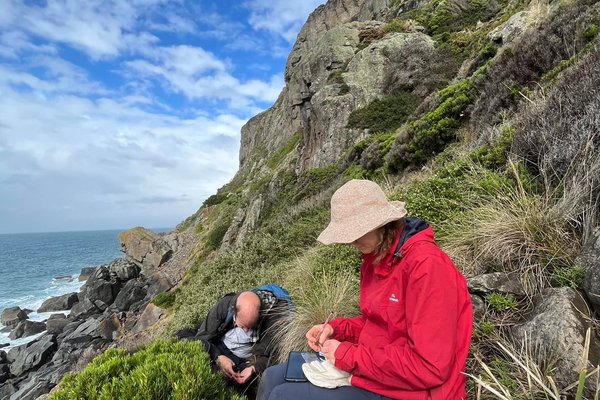Surviving Australia: Lessons from land snails
The appearance of a snail can be deceiving. By examining the DNA of a group of land snails, the Camaenidae, we’ve uncovered that in many cases, unrelated snail species have actually evolved to look nearly identical to each other. It seems that snail shells, at least in the group studied, are more related to the ecology of the species than its evolutionary history. Our results will help in correctly identifying and classifying snail species in Australia.
Australia harbours perhaps 2,000 species of land snail in more than 40 different families. Most of these families originated tens of million years ago, when lush rainforests covered vast parts of the continent. Since then, Australia’s climate has become increasingly dry. As a result of this aridification, rainforests contracted into small pockets along the east coast and the snails became trapped in these pockets as relics of times long gone.
The members of one family of land snail, the Camaenidae, have thrived under the new, more arid conditions forming a spectacular radiation throughout most of Australia. Using molecular techniques, we have studied the relationships of about 300 species from Australia’s far north-west to understand how these snails have coped with this aridification.

Large, subglobose, smooth, pale: A. Arnemelassa creedi. B. Parglogenia pelodes. C. Xanthomelon oqliquirugosa. D. Globorhagada prudhoensis.
Broadly subglobose, smooth, uniform colour: E. Mesodontrachia fitzroyana. F. Vincentrachia gregoriana. G. Nodulabium solidum. H. Ototrachia compressa.
Small, flat, wide umbilicus, keeled, with radial ribs: I. Nanotrachia orientalis. J. Mouldingia occidentalis.
Small, flat, wide umbilicus, rounded periphery, with periostracal hairs or projections: K. Baudinella baudinensis. L. Setobaudinia umbadayi. M. Trachiopsis victoriana.
Scale bar = 10 mm.
Image: Francesco Criscione & Frank Koehler© Australian Museum
Our study showed that several unrelated species have evolved very similar shell morphologies independently from each other (see figure above). This parallel evolution has bamboozled previous attempts to correctly identify and classify snail species because close similarity has always been presumed to indicate close relationships. Instead, the appearance of the shell reflects the ecology of species more than anything else.
So, why did such convergent forms evolve repeatedly amongst Australian land snails? We argue that the key to answer this question is past climate change. It is well-known that aridification has significantly altered natural habitats. For example, humid rainforests were progressively replaced with dry open woodland or savannah. As this process took place over hundreds of thousands or even millions of years, several land snail lineages managed to adapt to the changed conditions by undergoing changes in their anatomy, morphology as well as in their behaviour.
The modifications in their shell are particularly obvious and involve changes in colour, the flattening, miniaturisation or even enlargement of shells. However, these changes didn’t happen randomly, but in concert with shifts in behaviour and environment. For example, burrowing species have large and rounded shells while those living in rock crevices usually have flat shells. While adapting to more arid environment, the same behavioural and morphological changes have occurred in unrelated snail lineages producing snails with verysimilar appearances- a case of convergent evolution.
Our molecular findings will allow a more accurate classification of this snail group and help in the identification of our diverse and often threatened land snail fauna.
Dr Frank Koehler
Senior Research Scientist
More information:
Köhler, F., & Criscione, F. (2015). A molecular phylogeny of camaenid land snails from north-western Australia unravels widespread homoplasy in morphological characters (Gastropoda, Helicoidea). Molecular Phylogenetics and Evolution 83: 44-55










